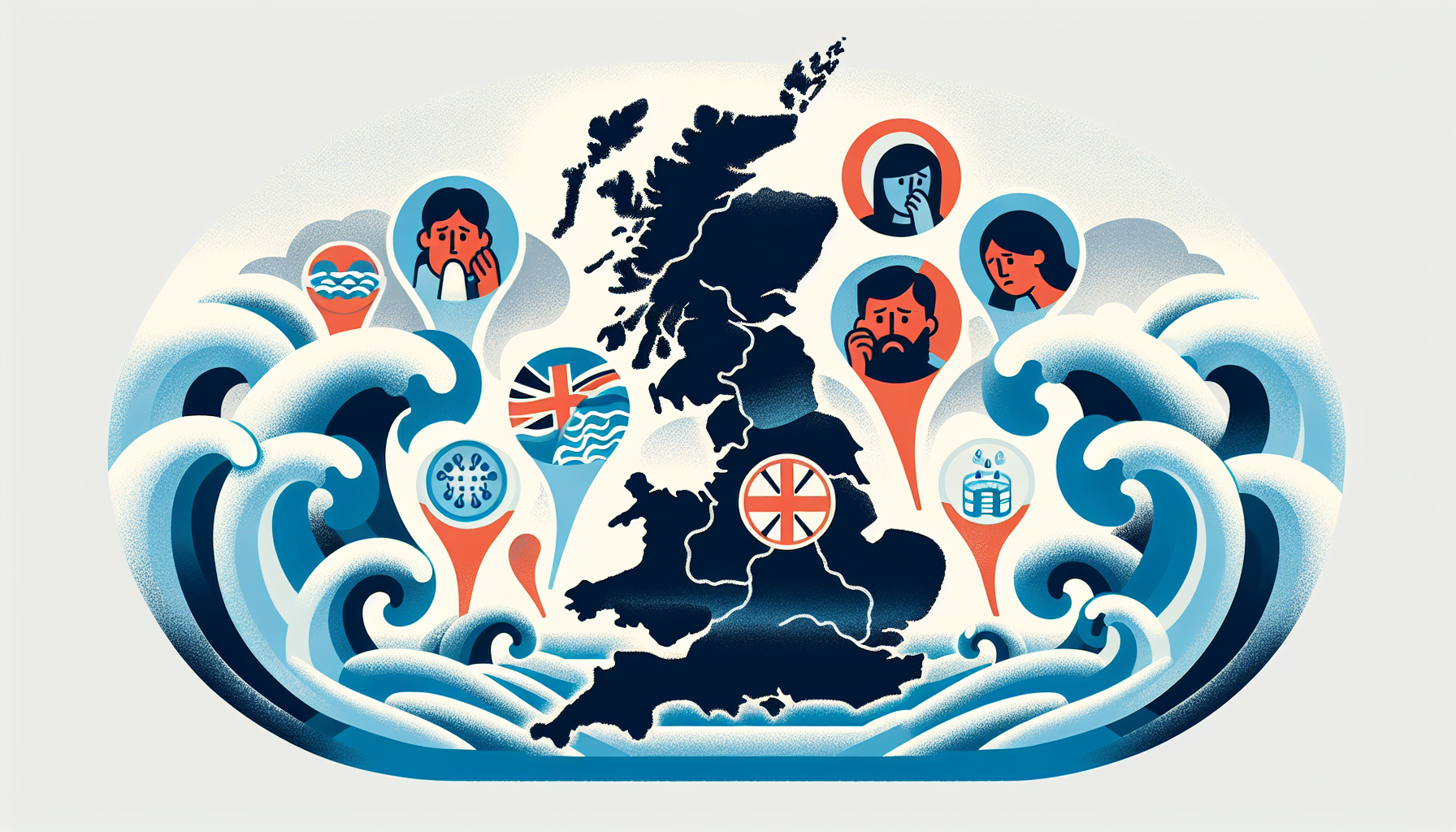
Extent of sewage discharge in 2024
In 2024, the United Kingdom experienced an alarming surge in sewage discharges into its waterways, with untreated waste being released more than 580,000 times. These discharges amounted to approximately 4.7 million hours of pollution, marking a significant increase from previous years. The scale of the problem has raised serious concerns among environmental groups, water quality advocates, and recreational water users, including surfers who frequent the UK’s coastal areas.
Much of the sewage overflow occurred during periods of heavy rainfall, when outdated combined sewer systems—designed to carry both rainwater and sewage—became overwhelmed. In such cases, water companies are permitted to release untreated waste directly into rivers and seas to prevent backups into homes and streets. However, the frequency and duration of these discharges in 2024 have drawn criticism, particularly as they often occurred in areas popular for water sports and outdoor recreation.
Surfers Against Sewage, a UK-based environmental charity, reported that many of the worst-hit locations were near popular surf breaks and beaches. These included stretches along the Cornish coast, parts of Devon, and areas near Brighton, where surfers and swimmers were exposed to potentially hazardous water conditions. The group’s real-time pollution alert system recorded thousands of warnings throughout the year, prompting calls for urgent action to address the crisis.
For Australian surfers keeping an eye on global surf destinations, the situation in the UK serves as a stark reminder of the importance of clean water for both health and enjoyment. The sheer volume of untreated waste entering the ocean not only affects local ecosystems but also poses a direct threat to anyone entering the water. With the UK’s surf scene growing in popularity, particularly among cold-water enthusiasts, the ongoing sewage issue has become a major deterrent for both locals and international visitors.
Environmental consequences of untreated waste
The environmental impact of untreated sewage entering the UK’s waterways in 2024 has been profound, with consequences rippling through marine ecosystems, public health, and recreational water use. When raw sewage is discharged into rivers and coastal areas, it introduces a toxic mix of pathogens, nutrients, and chemicals that disrupt the natural balance of aquatic environments. For surfers, swimmers, and other ocean users, this contamination translates into increased risks of illness, including gastrointestinal infections, skin rashes, and respiratory issues.
One of the most immediate effects of sewage pollution is the depletion of oxygen levels in water, a condition known as hypoxia. This occurs when excess nutrients, particularly nitrogen and phosphorus from human waste, fuel algal blooms that consume oxygen as they decompose. These low-oxygen zones can lead to fish kills and the collapse of local marine biodiversity. In areas like Cornwall and the south coast of England—regions popular with surfers—such ecological damage has been observed more frequently, with reports of dead marine life washing ashore following major discharge events.
Beyond the visible damage, untreated sewage also introduces microplastics, pharmaceuticals, and heavy metals into the marine environment. These pollutants accumulate in the food chain, affecting not only marine species but also the humans who consume seafood. For surfers, who often spend extended periods in the water and may inadvertently ingest small amounts, the long-term health implications are still being studied but are cause for concern.
In 2024, several UK beaches failed to meet minimum water quality standards during peak surf seasons, leading to temporary closures and public health advisories. This has had a direct impact on the surf community, with competitions postponed and surf schools forced to cancel lessons. For Australian surfers considering a trip to the UK’s renowned surf spots, the unpredictability of water quality has become a significant factor in travel planning.
Environmental groups have also raised alarms about the impact on marine wildlife, particularly in estuarine and coastal habitats where sewage tends to accumulate. Species such as seals, seabirds, and even dolphins have been observed in distress or found dead in areas affected by repeated discharges. These incidents underscore the broader ecological cost of failing to manage wastewater effectively.
For the global surf community, including those in Australia, the UK’s sewage crisis serves as a cautionary tale. It highlights the interconnectedness of environmental stewardship and recreational access, reminding surfers everywhere that clean waves depend on healthy ecosystems. As awareness grows, so too does the call for stronger protections and investments in infrastructure to safeguard the waters that surfers cherish.
Challenges facing UK water infrastructure
One of the core issues contributing to the UK’s sewage crisis is the aging and inadequate water infrastructure, much of which dates back to the Victorian era. These outdated systems were not designed to handle the demands of a modern population, let alone the increased frequency of extreme weather events linked to climate change. Combined sewer systems, which carry both rainwater and sewage in the same pipes, are particularly vulnerable. During heavy rainfall, these systems quickly reach capacity, forcing water companies to release untreated waste into rivers and seas to prevent urban flooding.
Investment in infrastructure upgrades has lagged behind the growing need. Water companies have faced criticism for prioritising shareholder dividends over essential maintenance and improvements. Despite rising profits, many providers have failed to reinvest sufficiently in modernising treatment plants or separating stormwater from sewage lines. This lack of proactive planning has left the system ill-equipped to cope with current environmental pressures, let alone future challenges.
Regulatory oversight has also come under scrutiny. The UK’s Environment Agency and Ofwat, the water industry regulator, have been accused of being too lenient in enforcing penalties and too slow in mandating infrastructure improvements. While some fines have been issued for illegal discharges, critics argue that these measures are not enough to drive systemic change. The result is a cycle of pollution, public outcry, and limited accountability.
For surfers and ocean users, the consequences of this failing infrastructure are felt directly in the water. In regions like Devon and Cornwall—home to some of the UK’s most iconic surf breaks—surfers have reported frequent exposure to polluted conditions, particularly after storms. The lack of real-time monitoring and transparency from water companies further compounds the problem, leaving surfers to rely on community-driven alert systems to avoid contaminated spots.
Efforts to modernise the UK’s water infrastructure are underway in some areas, with pilot projects exploring green infrastructure solutions such as sustainable urban drainage systems (SUDS), wetland restoration, and smart monitoring technologies. However, these initiatives remain limited in scope and funding. Environmental advocates argue that a nationwide overhaul is needed, with a focus on resilience, sustainability, and public health.
For Australian surfers watching from afar, the UK’s infrastructure challenges offer a stark lesson in the importance of long-term planning and investment. Australia’s own coastal communities, many of which rely on tourism and surf culture, could face similar issues if infrastructure is not maintained and adapted to changing environmental conditions. The UK’s experience underscores the need for vigilance, advocacy, and innovation to protect the waters that surfers around the world depend on.
Extent of sewage pollution in 2024
In 2024, the UK’s waterways copped a filthy blow — sewage was pumped into rivers, lakes and coastal zones more than 580,000 times. That’s not a typo, mate. We’re talking about roughly 4.7 million hours of untreated waste flowing straight into the wild. That’s over 535 years’ worth of continuous discharge. Crikey.
These aren’t just little leaks either. From the Scottish Highlands to the Cornish coast, the spills were widespread, affecting popular surf breaks, fishing spots and inland waterways. If you were planning a paddle or casting a line, you’d want to check the water quality first — or risk coming out smelling like a dodgy prawn on a hot day.
The data, released by the Environment Agency, shows a 54% increase in discharge hours compared to 2023. That’s a massive jump, and it’s got locals and environmental groups frothing — and not in a good way. The worst-hit areas saw thousands of hours of sewage flow, with some spots getting hammered almost daily.
“It’s like trying to surf in a toilet,” one local surfer from Cornwall was quoted saying. Fair call, mate.
While the UK’s water companies blame heavy rainfall and ageing infrastructure, critics reckon it’s more about poor planning and lack of investment. Either way, the result is the same — murky waters, dodgy smells, and a serious buzzkill for anyone chasing clean waves or a decent catch.
Environmental and infrastructure implications
Turns out, the UK’s water infrastructure is about as sturdy as a sandcastle at high tide. Much of the system dates back to the Victorian era — yep, that’s 1800s tech still trying to handle 2024’s storm surges and population booms. Combine that with climate change bringing heavier downpours, and you’ve got a recipe for overflow disasters every time the skies open up.
Water companies have been copping flak for not upgrading fast enough. Instead of investing in modern treatment plants and stormwater separation, they’ve been relying on combined sewer overflows — basically pressure valves that dump untreated sewage straight into the nearest waterway when the pipes get too full. It’s like unclogging your loo by tipping it into the backyard. Not ideal, especially when that backyard is a world-class surf break or a prized trout stream.
Environmental watchdogs are warning that the constant flow of waste is hammering aquatic ecosystems. Fish stocks are taking a hit, with oxygen levels dropping and toxic algal blooms on the rise. That’s bad news for anglers chasing a feed and for the marine life trying to survive in what’s fast becoming a chemical soup.
- Increased bacteria levels are making some beaches unsafe for swimming — even during peak summer.
- Shellfish beds are being closed due to contamination, hitting local fisheries hard.
- Surfers and swimmers are reporting more cases of ear infections, stomach bugs and skin rashes after sessions in affected waters.
And while the water companies are promising billions in upgrades over the next decade, many reckon it’s too little, too late. Locals are calling for tougher penalties and faster action — because no one wants to paddle out into a brown slick or reel in a fish that smells like a blocked dunny.
“We’re not asking for crystal-clear Fiji water,” said one angler from Yorkshire. “Just something that doesn’t make your eyes water when you gut a fish.”
Until the pipes get sorted and the spills stop, it’s a game of Russian roulette every time you hit the water. So if you’re heading over for a surf trip or a fishing mission, maybe pack some nose plugs — and a strong stomach.

